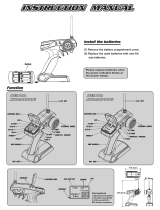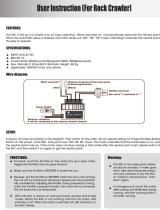
TRAXXAS
•
19
Patented Training Mode
(Profile #3) reduces forward
and reverse throttle by 50%.
Training Mode is provided
to reduce the power output,
allowing beginning drivers to
better control the model. As
driving skills improve, simply
change to Sport or Race Mode
for full-power operation.
Tip For Fast Mode Changes
The XL-5 is set to Profile 1 (Sport
Mode) as the default. To quickly
change to Profile 3 (Training
Mode), with the transmitter on,
press and hold the EZ-Set button
until the light blinks red three
times and then release. For full
power, quickly change back
to Profile 1 (Sport Mode) by
pressing and holding the EZ-Set
button until the light blinks red
one time and then releasing.
ADJUSTING THE ELECTRONIC SPEED CONTROL
XL-5 Operation
To operate the speed control and test the programming, reconnect
the motor wires and place the vehicle on a stable block or stand so
that all of the driven wheels are off the ground.
Note that in steps 1-8 below, Low-Voltage Detection is DISABLED
(factory default) and the LED shines red. If Low-Voltage Detection is
ACTIVATED, the LED will shine green instead of red in steps 1-8 below.
Never use LiPo batteries while Low-Voltage Detection is disabled.
1. With the transmitter on, press and release the EZ-Set button.
The LED will shine RED. This turns the XL-5 on. If you press and
release too quickly, you may hear the steering servo jump but
the LED may not stay on. Simply press the button again until the
LED shines RED and then release.
2. Apply forward throttle. The LED will turn off until full throttle
power is reached. At full throttle, the LED will shine RED.
3. Move the trigger forward to apply the brakes. Note that braking
control is fully proportional. The LED will turn off until full
braking power is reached. At full brakes, the LED will shine RED.
4. Return the throttle trigger to neutral. The LED will shine RED.
5. Move the throttle trigger forward again to engage reverse
(Profile #1). The LED will turn off. Once full reverse power is
reached, the LED will shine RED.
6. To stop, return the throttle trigger to neutral. Note that there is
no programmed delay when changing from reverse to forward.
Use caution to avoid slamming the speed control from reverse
to forward. On high-traction surfaces, this could result in
transmission or driveline damage.
7. To turn the XL-5 off, press and hold the EZ-Set button for 1½
seconds or until the red LED turns off.
8. The XL-5 is equipped with thermal shutdown protection to
guard against overheating caused by excessive current flow.
If the operating temperature exceeds safe limits, the XL-5 will
automatically shut down. The LED on the face of the XL-5 will
rapidly blink red, even if the throttle trigger is moved back and
forth. Once the temperature returns to a safe level, the XL-5 will
once again function normally.
XL-5 Profile Selection
The speed control is factory set to Sport Mode (100% forward,
brakes, and reverse). To disable reverse (Race Mode) or to allow
50% power (patented Training Mode), follow these steps. The speed
control should be connected to the receiver and the transmitter
adjusted as described previously. The profiles are selected by
entering the programming mode.
Profile Description
Profile #1 (Sport Mode): 100% Forward, 100% Brakes, 100% Reverse
Profile #2 (Race Mode): 100% Forward, 100% Brakes, No Reverse
Profile #3 (Training Mode): 50% Forward, 100% Brakes, 50% Reverse
Selecting Sport Mode
(Profile #1: 100% Forward, 100% Brakes, 100% Reverse)
1. Connect a fully charged battery
pack to the XL-5 and turn on your
transmitter.
2. With the XL-5 off, press and hold
the EZ-Set button until the LED turns
solid green, then solid red and then
begins blinking red (indicating the
Profile numbers).
3. When the LED blinks RED ONCE,
release the EZ-Set button.
4. The LED will blink and then turn solid green (Low-Voltage
Detection ACTIVE) or red (Low-Voltage Detection DISABLED). The
model is ready to drive.
Selecting Race Mode
(Profile #2: 100% Forward, 100% Brakes, No Reverse)
1. Connect a fully charged battery pack to
the XL-5 and turn on your transmitter.
2. With the XL-5 off, press and hold
the EZ-Set button until the LED turns
solid green, then solid red and then
begins blinking red (indicating the
Profile numbers).
3. When the LED blinks RED TWICE,
release the EZ-Set button.
4. The LED will blink and then turn solid green (Low-Voltage
Detection ACTIVE) or red (Low-Voltage Detection DISABLED). The
model is ready to drive.
B
One blink Red
A
Green to Red to Off
D
Solid
C
Release
B
Two blinks Red
A
Green to Red to Off
D
Solid
C
Release
























